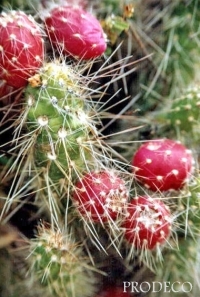The botanist Alberto Vojtěch Frič named the genus of the Tunilla 'Airampoa'. Sources state the name 'Ayrampo' to be of Quechuan origin [1] [8]. Therefor several other transcriptions exist, like "Ayranpu [7] [8]", "Haranpu [8]", "Ayrampu [6]", "Airampo [2] [3] [6]", "Airampu [9]" or "Irampo [1]".
 >Ayrampo - Ein andiner Feigenkaktus
>Ayrampo - Ein andiner FeigenkaktusHabitat
Ayrampo is an endemic species in the south of Peru, Bolivia, north of Chile and the north of Argentina in heights above 3'000m [5]. It grows strongest between 3'300 and 4'000m. [5]Human usage of Ayrampo
Technical use
The flower and fruit are natural dyes, having a dark carmine color used for dying fibers like wool. [2] [5] [6] [9]Culinary use
Medical use
- Antipyretic
The infusion made with the seeds reduces or limits high fever. [2] [3] [4] [6] [8] - Antiphlogistic
The infusion is also a treatment against inflammations [5] of mucous membranes, like conjunctivitis (extertanally) [4] [6] [8] or ulcers like aphths (recurring oral aphthae and recurrent aphthous ulceration) [1] [4] [6] or peptic ulcers [2]. - Laxative
The juice of the quenched cladodes has a purgative effect. [1]
Scientific classification of Ayrampo
Domain: Eukaryota(unranked): Archaeplastida
Kingdom: Plants (Plantae)
Subkingdom: Embryophyta
Class: Magnoliopsida
(unranked): Eudicots
(unranked): Core eudicots
Order: Caryophyllales
Family: Cactaceae
Subfamily: Opuntioideae
Tribe: Opuntieae
Genus: Tunilla
Species: T. soehrensii
Former scientific name
Opuntia soehrensis [1] / Opuntia soehrensii [2] [4] [8] from 1919 (first descripcion by Nathaniel Lord Britton and Joseph Nelson Rose [8]) to 2000 (establishment of the genus Tunilla by David Richard Hunt und James Iliff).
Discription
Tunilla soehrensii grows into dense, tangled structures not higher than 30cm [1] to 50cm [2].
Cladodes
Tunilla soehrensii typically grows with flattend, but almost cylindrical [1], rounded cladodes (also called platyclades) with a length of up to 6cm. They are protected with 7cm long spines.
Flower
Its 5,5cm long flowers are of dark red [1] [3] or yellow [2] [3] [8], sometimes of orange, red or pinkish color.
Fruit
Its 2,5cm long fragil fruits have a dark red color [1] [5] (or green [2] [3]? {probably when immature}), containing seeds of similar red color [1] [2] [3] [8].
The fruits can be harvested when they turn red; between April and first half of June. [5]
Cladodes
Tunilla soehrensii typically grows with flattend, but almost cylindrical [1], rounded cladodes (also called platyclades) with a length of up to 6cm. They are protected with 7cm long spines.
Flower
Its 5,5cm long flowers are of dark red [1] [3] or yellow [2] [3] [8], sometimes of orange, red or pinkish color.
Fruit
Its 2,5cm long fragil fruits have a dark red color [1] [5] (or green [2] [3]? {probably when immature}), containing seeds of similar red color [1] [2] [3] [8].
The fruits can be harvested when they turn red; between April and first half of June. [5]
_________________
[1] Entry at Medicina Intercultural 2013/11/03 [es]
>http://medicinaintercultural.org/cd/plantas/airampo
[2] Article on La Patria online 2013/11/05 [es]
>http://lapatriaenlinea.com/?nota=23792
[3] Article on Peru this Week 2013/11/03 [en]
>Airampo: the Andean fruit with medicinal properties and favored y gourment chefs
[4] Article on Olimpiadas Nacionales de Contenidos Educativos en Internet 2013/11/04 [es]
>Plantas que curan
[5] Article on buenas tareas 2013/11/04 [es]
>Ayrampo by samayanierman
[6] Article on Diagnostico Medico 2013/11/04 [es]
>El airampo, bueno para regular la presíon sanguínea
[7] Excerpt from Religion und Riten der Aymarà 2013/11/05 [de]
>In einigen Orten...werden noch die Früchte des Ayranpu verwendet...und deren Sauerkirschfarbe...
[8] Entry at El Diccionario Quechua - Espanol - Quechua 2013/11/05 [es]
>http://www.cuscocultural.com/listadiccionario.php?letra=A&indice=y&con=ayranpu.
[9] Text on awajwarmi.com 2013/11/05 [de, es]
>...con rojo del airampu (fruto cactáceo andino)...





 This Blog is dedicated to "
This Blog is dedicated to "







No comments:
Post a Comment